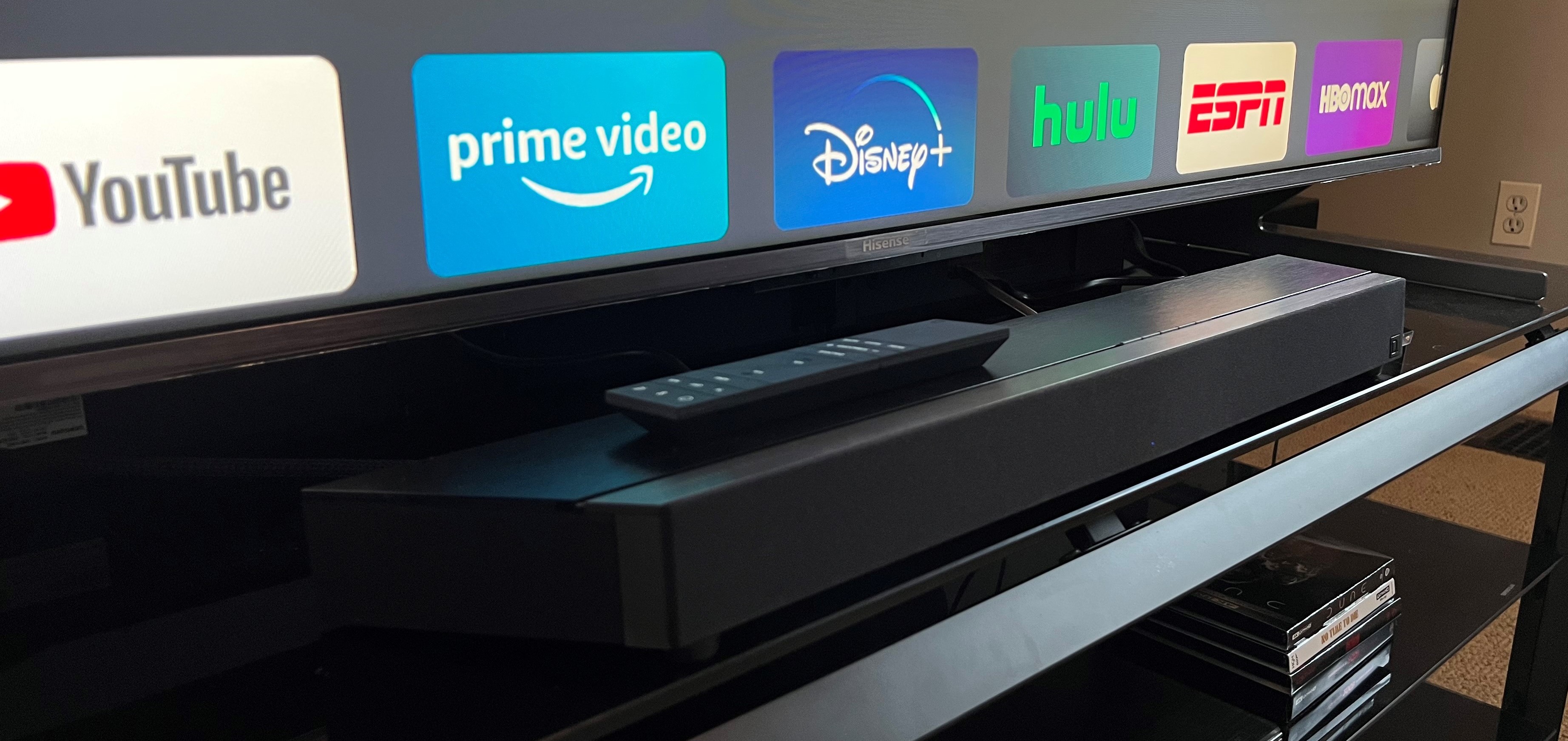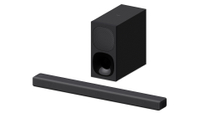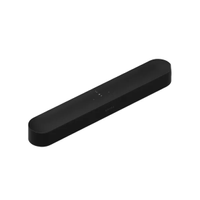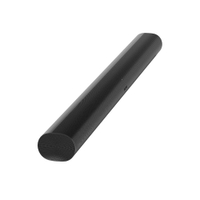TechRadar Verdict
The Definitive Technology Studio 3D Mini, a compact soundbar system from a traditional speaker-maker, distinguishes itself through impressive performance and an ability to stream audio (including high-res) directly from music services over Wi-Fi. Its HDMI ports lacks support for some of the latest gaming-related features, but overall it’s a great, though slightly pricey option for upgrading your TV’s audio.
Pros
- +
Very good overall sound quality
- +
Virtual Dolby Atmos and DTS:X processing
- +
HDMI eARC and HDMI input ports
- +
High-res-compatible HEOS wireless streaming platform
Cons
- -
HDMI pass-through doesn’t support VRR and ALLM
- -
Basic front-panel display
- -
Pricey compared to competition
Why you can trust TechRadar
Definitive Technology Studio 3D Mini: One-minute review
The Definitive Technology Studio 3D Mini is a compact 4.1-channel soundbar system that manages to outperform other compact ‘bars through a combination of virtual Dolby Atmos and DTS:X processing and potent, extended bass provided by its wireless subwoofer.
Coming from a company with a long history of speaker design and manufacturing, it’s not surprising that the Def Tech Studio 3D Mini simply sounds good: as soon as you connect it to your TV, you’ll notice the substantial upgrade in audio quality it delivers, adding clarity to dialogue and both drama and a sense of real envelopment in action movies. And movies and TV sound isn’t the only thing the Studio 3D Mini does well. Music played over the system benefits from a pleasingly warm tonal balance, and stereo separation is better than expected for a compact soundbar.
On the features front, the Def Tech’s HDMI eARC port is supplemented by an HDMI input for connecting a Blu-ray player or game console. And while pass-through of 4K and Dolby Vision HDR is supported, gaming-related features like 4K/120Hz, VRR, and ALLM are not. Built-in Wi-Fi expands streaming capabilities to services like Spotify, Amazon Music Unlimited, and Tidal, and the HEOS platform that Def Tech uses is also high-res capable.
HEOS also lets you link the soundbar to other HEOS-compatible wireless speakers and audio components (currently limited to models from Denon and Marantz) in a multiroom audio setup so you can steer music to all connected devices using the HEOS control app. And while the app gets the job done, it’s not as sophisticated or user-friendly as the ones used by competing wireless platforms like Sonos.
Looking beyond features and specs, Def Tech’s soundbar has a unique design, and it should merge nicely with any home A/V layout. It doesn’t have the large alphanumeric LED display used by other soundbars for control feedback, which is a disappointment at this price point. It does come with a much-better-than-average full-scale remote control, however, which is a welcome feature for a soundbar.
Value is where the Def Tech comes up a bit short. For its asking price, you could instead buy the formidable Sonos Arc, which has a distinct advantage when it comes to presentation of immersive audio (not to mention the Sonos S2 control app and other features like Trueplay room correction). But overall, there’s plenty here to like, even if Def Tech is going up against some tough competition.
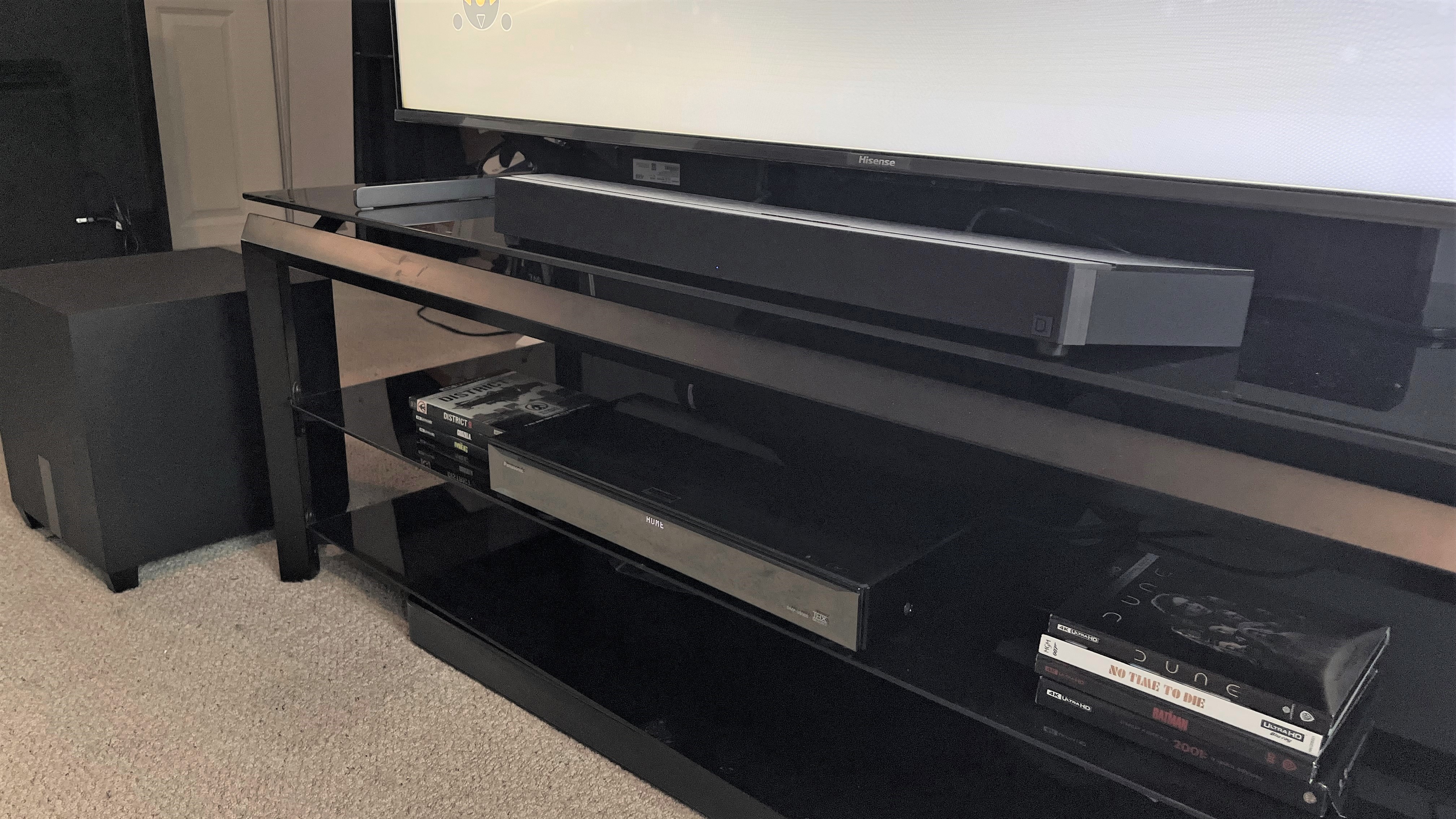
Definitive Technology Studio 3D Mini: Price and release date
- Released in December 2020
- $899 / £800 / AU$1,380
Def Tech’s Studio 3D Mini was released in December 2020 for $899 / £749 / AU$999. It is currently selling for that price, though it regularly sees discounts of $100 or more.
The Studio 3D Mini is priced at the higher end of the soundbar spectrum and costs about the same as the Sonos Arc. Def Tech’s soundbar lacks the Arc’s up-firing speakers for conveying Dolby Atmos and DTS:X height effects, however, relying instead on virtual processing to create immersive sound.
A more direct competitor would be the Sonos Beam, a similarly compact model with virtual Dolby Atmos processing that’s priced at around $450. But the Studio 3D Mini comes with a wireless subwoofer for extended bass – a feature the Beam lacks.
Definitive Technology Studio 3D Mini review: features
- 4.1-channel with virtual Dolby Atmos and DTS:X sound
- HDMI eARC with 4K and Dolby Vision pass-through
- Wi-Fi, AirPlay 2 and Bluetooth wireless streaming
The Studio 3D Mini is a 4.1-channel soundbar system that supports both the Dolby Atmos and DTS:X immersive soundtrack formats. The soundbar uses two 1 x 3-inch ovoid drivers paired with 1-inch aluminum dome tweeters for the front channels and has an additional 1 x 3-inch ovoid driver on each of its angled sides that are meant to increase soundstage width and contribute to surround sound envelopment. The system includes a wireless sub with an 8-inch woofer. Amplifier power for both the ‘bar and subwoofer aren’t specified.
The soundbar has an HDMI eARC port for a TV connection plus an HDMI input that provides 4K and Dolby Vision HDR pass-through, though HDR10+, 120 Hz, VRR, and ALLM are not supported. There’s also an optical digital port and an AUX input for making an analog audio connection.
Wireless connection options include Wi-Fi, Bluetooth, and AirPlay 2. The Studio Mini 3D also supports the HEOS streaming protocol, which is controlled using the HEOS iOS/Android app. This lets users stream audio directly to the bar via Wi-Fi from services including Spotify, Tidal, Amazon Music Unlimited, Deezer, Pandora, and TuneIn internet radio, along with music files located on a PC or network-attached storage.
HEOS’s multiroom streaming capability also lets users link the Studio 3D Mini to other wireless audio components and speakers from HEOS-compatible brands like Denon and Marantz. Support for Google, Alexa, and Siri voice assistants is onboard, giving you hands-free operation over basic controls like volume and track skipping.
Along with Dolby Atmos and DTS:X, processing modes on the Studio 3D Mini include Dolby Surround and DTS Virtual:X for upmixing stereo soundtracks. There’s also a Music (stereo, unprocessed) mode, 3-step dialogue enhancement, and a Night mode that compresses dynamic range to reduce overall loudness.
Definitive Technology doesn’t provide an option to upgrade the Studio 3D Mini with wireless surround speakers.
- Features score: 4/5
Definitive Technology Studio 3D Mini review: sound quality
- Very good dialogue clarity
- Decent level of height and width from virtual processing
- Well-integrated bass
I have long familiarity with Definitive Technology’s regular speakers, which have consistently sounded very good over the many decades the company has been making them. Given that history, I had high expectations for the Studio 3D Mini soundbar’s sound, and was not disappointed.
With the subwoofer positioned close to the soundbar, the transition between the bass and the upper-range sound was impressively smooth. To optimize subwoofer level, I watched a cooking show (a dependable source of non-stop onscreen chatter) and adjusted the bass until a male chef’s voice sounded clean and not overly chesty or boomy.
Once the bass dialed in, I was happy with the way TV and movie dialogue sounded coming from the Def Tech: clear and well-defined, with none of the edginess or cabinet resonance you sometimes hear with lesser soundbars.
Going straight to movie torture tests, I loaded Godzilla (2014) into my Ultra HD Blu-ray player and let a scene rip where the radiation-eating MUTO creature is awakened and starts destroying a nuclear power plant. The clanging sounds of metal structures being dismantled, along with the hissing of malfunctioning equipment, were vividly rendered by the Studio 3D Mini. And while there wasn’t much in the way of a surround effect, the sound coming from the side-firing speakers resulted in a wider-than-anticipated presentation.
And a taller-than-expected one as well. With no up-firing drivers on the Studio 3D Mini to bounce sound off my ceiling, the helicopters trailing the MUTO in a later scene in Hawaii didn’t exactly seem like they were circling overhead, but the sound seemed to be coming from the TV’s screen as opposed to the ‘bar beneath it. And when Godzilla showed up to dispatch the unwholesome creature, his accompanying footfall had an impressive impact.
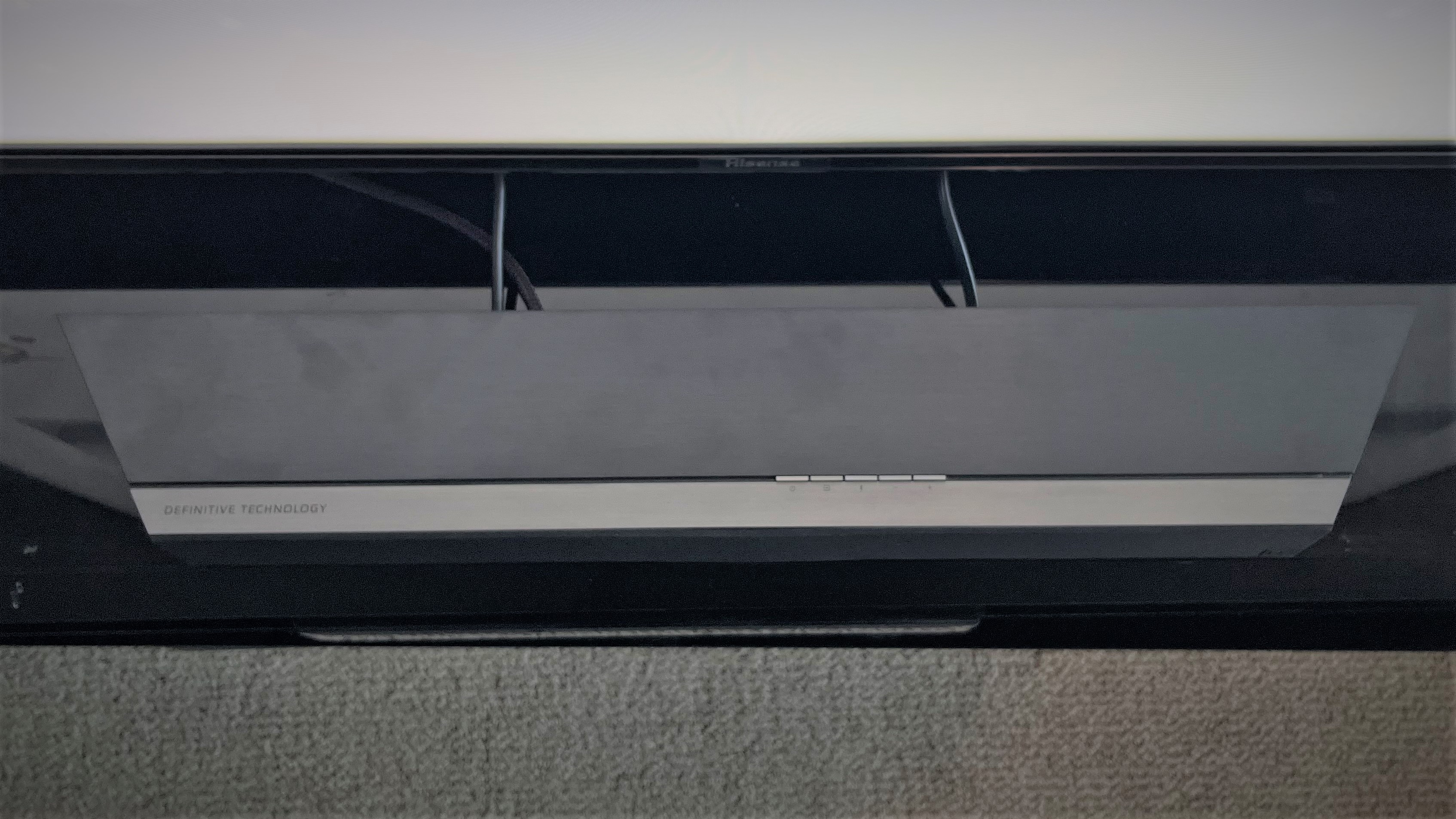
How good was the bass? Though it lacked the extension and full-throttle low-end output capability I’m used to hearing from my regular subwoofer, it was strong enough to make the sound of buildings being destroyed by the creatures if not authentic, then believable. Watching another sci-fi movie, District 9, the deep, guttural sound of the aliens’ voices was rendered cleanly, and gunfire from heavy artillery had an appropriately explosive quality.
Music also sounded very good on the Def Tech. I usually head into this part of a soundbar test with low expectations, but in this case I was pleasantly surprised by how well the Studio 3D Mini pulled it off. Streaming “Bahia” by Anouar Brahem on Tidal, the acoustic instruments played by the oud master and his jazz quartet had a natural tone and a good sense of ambience. The stand-up bass sounded well integrated even when playing deep notes, and I didn’t hear a hint of boom.
Playing another track from Tidal, “LA Trance” by Four Tet, the presentation was clean and mostly unstrained at loud levels. Here again the bass was well integrated with the overall sound, and there was a wider than average stereo image for a compact soundbar.
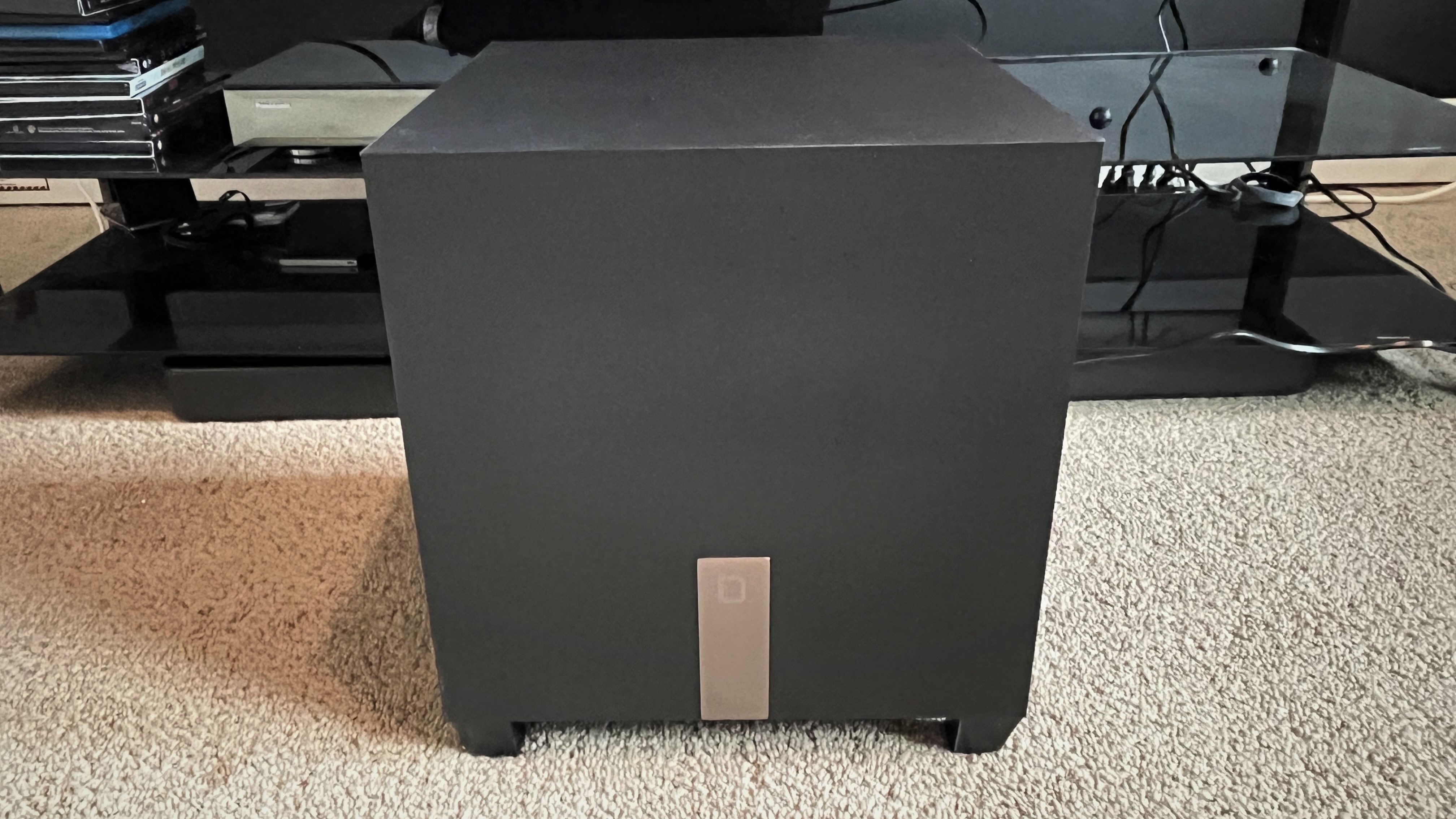
- Sound quality score: 4/5
Definitive Technology Studio 3D Mini review: Design
- Unique form-factor
- Speakers on angled sides expand soundstage
- Sleek external subwoofer
With its starkly angled sides, the Studio 3D Mini is both eye-catching and a welcome variation on the basic design of most ‘bars. At around 26 inches wide by 2 inches high and 4.5 inches deep, it’s very compact, and about the same size as the Sonos Beam.
The dark gray plastic case features a black fabric grille on the front and sides, and there’s an aluminum strip running across the top with control buttons in case you misplace the remote. A set of LEDs light up in various configurations to provide feedback to remote control commands, though you’ll need to spend time memorizing the sequences (they are detailed in the system’s online manual).
Def Tech’s subwoofer measures 12.5 x 14 x 12.5 inches (W x H x D) and has a sleek and elegant look for a compact sub that’s been packaged with a soundbar. Four rubber feet elevate the cabinet off the floor and provide clearance for its bottom-mounted 8-inch woofer and port.
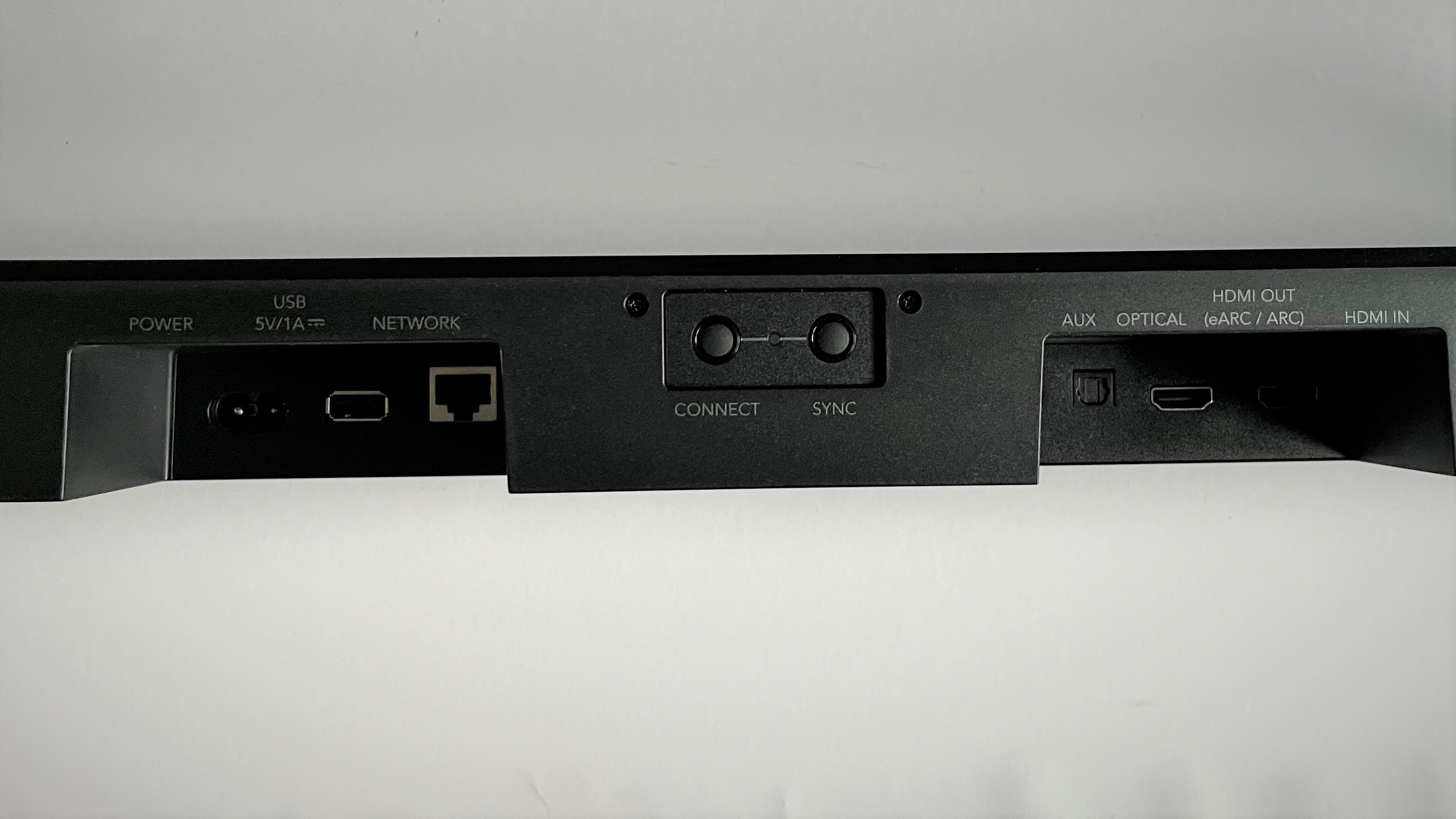
- Design score: 4/5
Definitive Technology Studio 3D Mini review: Usability and setup
- HDMI pass-through with eARC eases setup
- Full-scale remote along with HEOS control app
- No alphanumeric front panel display
The Studio 3D Mini’s HDMI eARC output makes setup as simple as linking it to your TV’s HDMI eARC (or ARC) port. Once that’s done, you can stream audio from your TV’s built-in apps, and also control the soundbar’s volume level using the set’s own remote control instead of the one that’s packaged with the soundbar.
A second HDMI port lets you connect a game console or Blu-ray player with video pass-through to the TV. For the latter case you can also control basic disc playback (play, pause, chapter skip) via the HDMI-CEC protocol, which simply works without any additional setup.
The wireless subwoofer pairs automatically with the soundbar when you turn it on. Beyond that, you can set the subwoofer level with Def Tech’s remote, which also provides dedicated controls to adjust volume, switch inputs, and select both the dialogue enhancement level and the Music, Movie, and Night processing modes. I appreciated that the remote was a full-size version with well-marked controls, something that’s usually not the case with soundbar handsets.
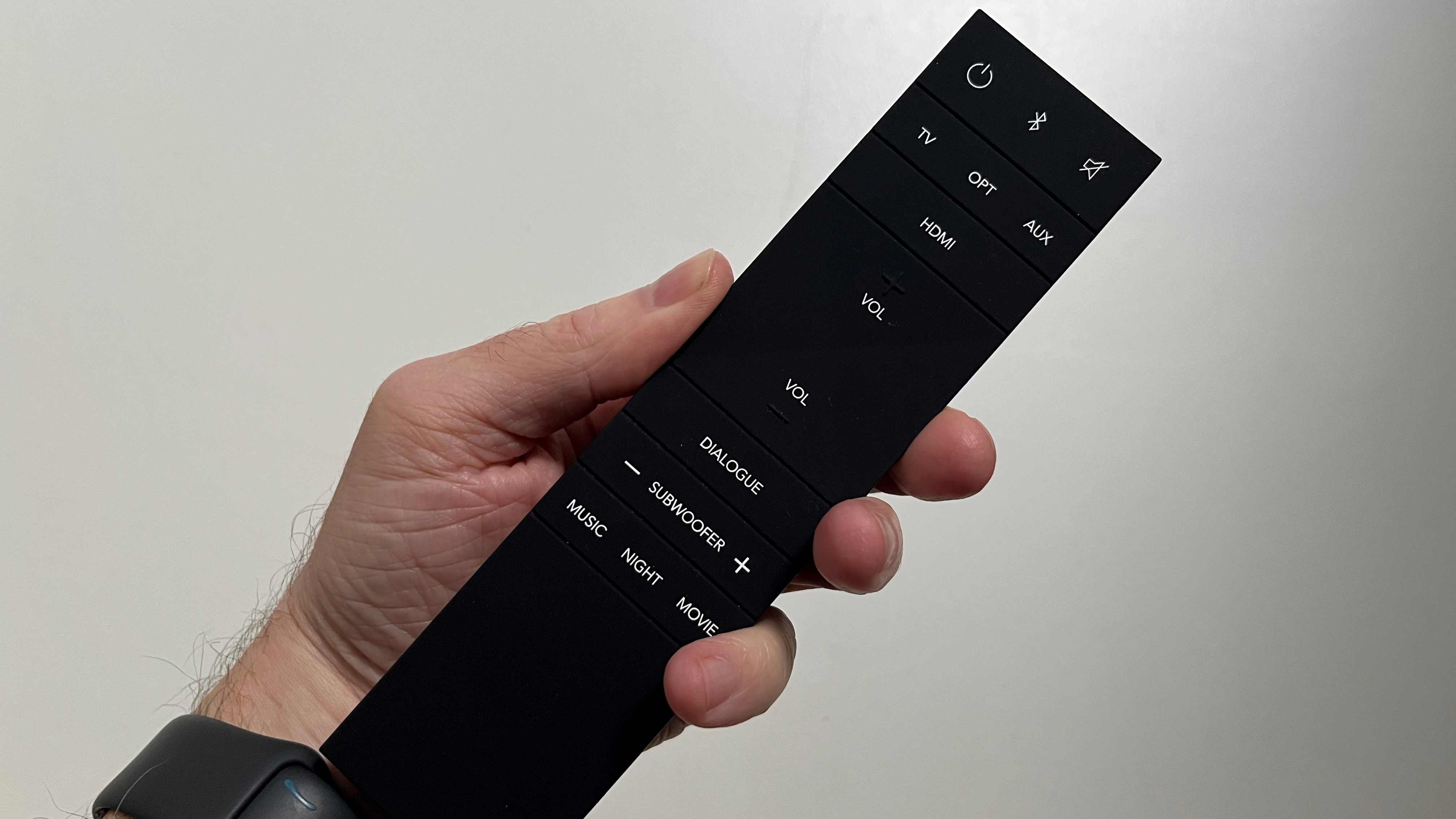
One thing that should be expected in a soundbar at this price is an alphanumeric front-panel LED display. Instead, the Def Tech uses the same basic strip of indicator lights, one that changes color and sequence in response to remote control commands, that you’ll find on $300-and-under soundbars.
You’ll get better and more extensive feedback when using the HEOS app, which is also used to stream music from a range of services, as well as control the soundbar’s general functions either alone or as part of a multiroom music system. Compared to other control apps from brands like Sonos, the HEOS one is pretty basic, and I also found it annoying to use when I was searching for music on the Tidal app. Mainly, I was disappointed that I could only browse albums and tracks in my collection in alphabetical order as opposed to sorting them by date added.
- Usability and setup score: 4/5
Definitive Technology Studio 3D Mini review: Value
- A bit pricey for what it offers
- Regularly sees discounts
At $899, the Studio 3D Mini faces some stiff soundbar competition. For the same price, you could buy the Sonos Arc, which will give you the benefit of up-firing drivers for more authentically immersive Dolby Atmos audio, as well as that company’s superior control app.
And there are other, less expensive options found on our list of the best soundbars like the $600 Sony HT-G700 and $450 Sonos Beam (Gen 2). Both of those models also offer virtual Dolby Atmos processing (plus DTS:X on the Sony), and the Sony comes with a wireless subwoofer for extended bass.
Given those other options, the Def Tech comes off as a bit pricey for what if offers, though its compact form factor and unique design, HEOS wireless capability, and impressive overall performance make it a solid soundbar choice. Keep an eye out for discounts, which occur regularly.
- Value score: 3.5/5
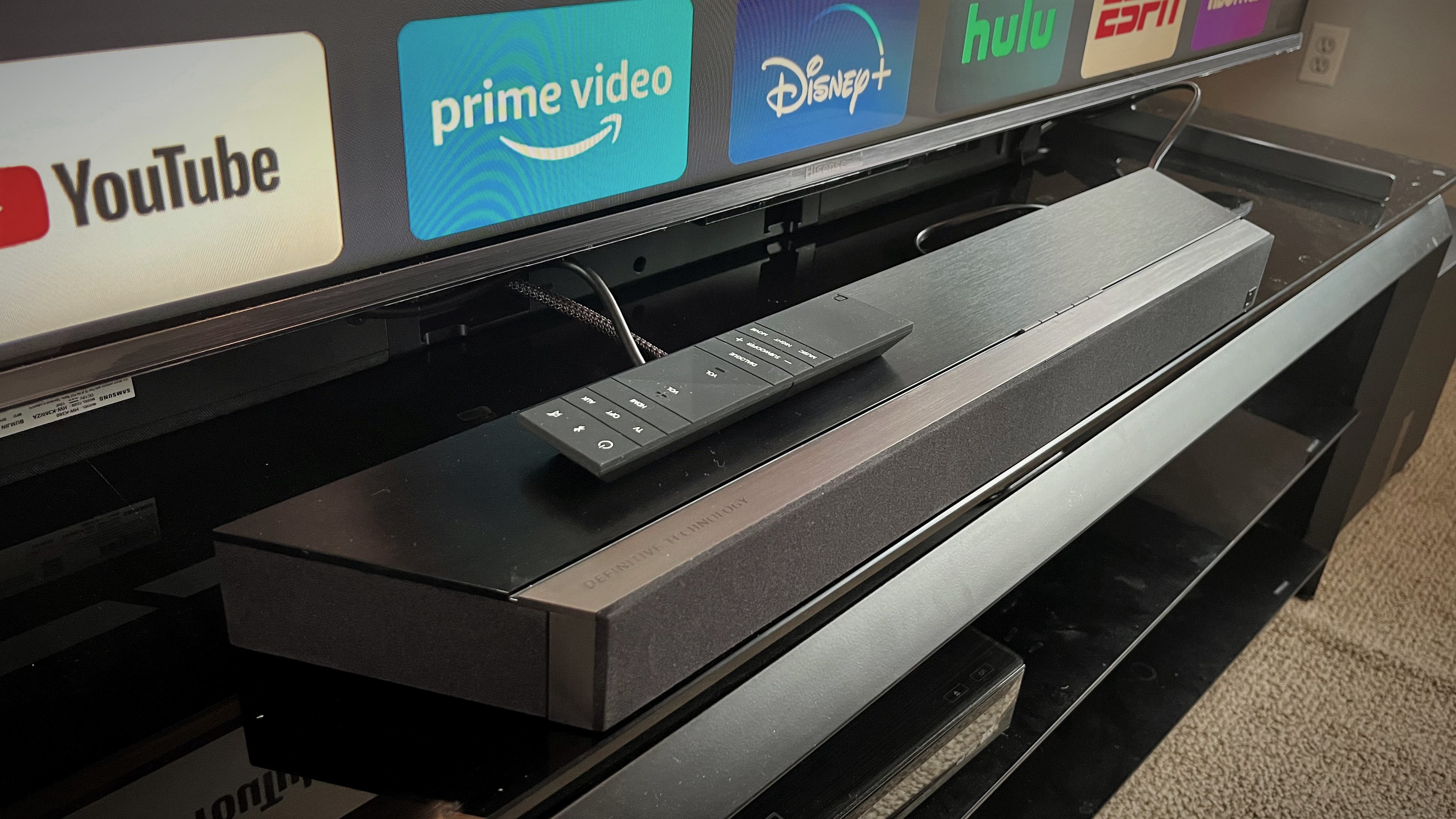
Should I buy the Definitive Technology Studio 3D Mini?
| Attributes | Notes | Rating |
|---|---|---|
| Features | HDMI eARC plus HDMI pass-through and Wi-Fi streaming | 4/5 |
| Sound quality | Very good dialogue clarity and music performance | 4/5 |
| Design | Unique compact design with good looks | 4/5 |
| Usability and setup | Easy set-up and app-based control | 4/5 |
| Value | A bit overpriced for what you get | 3.5/5 |
Buy it if…
You want a soundbar with a subwoofer
The compact Studio 3D Mini’s bundled external subwoofer lends it impressive bass punch, and bass extension is better than what you get from integrated soundbars.
You want Wi-Fi streaming, including high-res audio
The system’s HEOS wireless platform allows for direct Wi-Fi streaming from a range of apps, and it also allows for playback of high-res audio files from a PC or NAS.
You want Atmos and DTS:X
Both Dolby Atmos and DTS:X processing are built in to Def Tech’s soundbar.
Don't buy it if…
You might want to upgrade with surround speakers
The Studio 3D Mini doesn’t include wireless rear speakers, and there’s no add-on option if you later decide you want full-scale surround sound.
You expect “real” height effects
While the Def Tech’s virtual Dolby Atmos and DTS:X presentation provides a semblance of height effects, it’s not as powerful as what you’d get from a soundbar with up-firing speakers.
Also consider
Sony HT-G700
Sony’s 3.1-channel soundbar system also offers both virtual processing of Dolby Atmos and DTS:X soundtracks and it includes an external subwoofer. There’s no Wi-Fi streaming, but, like the Def Tech, it has both an HDMI input and an HDMI eARC connection and is priced several hundred dollars less.
Sonos Beam (Gen 2)
Another compact soundbar with virtual surround processing (for Dolby Atmos and standard DTS) plus Wi-Fi streaming and app-based control, Sonos’ mid-range Beam (Gen 2) costs half as much as Def Tech’s ‘bar. There’s no external subwoofer, however, and the sound is light on bass.
Sonos Arc
This flagship soundbar from Sonos packs a lot of drivers into a single soundbar, letting you get both overhead Atmos effects and a semblance of surround. With no subwoofer, there’s relatively limited bass, but the price is the same as Def Tech’s system.
- First reviewed: October 2022
- How we test: read TechRadar's reviews guarantee

Al Griffin has been writing about and reviewing A/V tech since the days LaserDiscs roamed the earth, and was previously the editor of Sound & Vision magazine.
When not reviewing the latest and greatest gear or watching movies at home, he can usually be found out and about on a bike.
